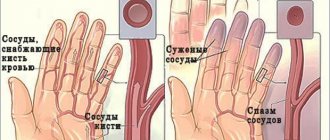On a note!
Any amateur activity in the treatment of tremor can have disastrous consequences.
Among the foods that cause trembling are coffee, alcohol, and strong tea. Drug use can also cause pathology.
For treatment, the specialist prescribes anticonvulsants. It is good to take a course of vitamin therapy. If necessary, surgical intervention is performed. Among the folk remedies that are recommended for tremors are decoctions of soothing herbs. These are mint, motherwort, valerian, plantain.
It is useful to use restoratives during this period.
Ginger, lemon, St. John's wort will have a beneficial effect on the body's immune system.
During the treatment period, you should perform exercises that develop fine motor skills of the hands.
It is no coincidence that in kindergarten children sculpt various crafts from plasticine, cut out small parts and glue appliqués. Such activities develop fingers and hands well and activate the brain.
If necessary, the doctor will prescribe a number of unconventional procedures to help get rid of shaking hands.
This could be acupuncture, herbal medicine, therapeutic fasting. These methods must be prescribed by the attending physician and undergo constant supervision by a specialist.
Maxim Bolotov, neurologist, St. Petersburg. “Tremor treatment is a rather lengthy but effective process. It is important that during such a period the patient is protected from worries and comfortable conditions are created. With the joint efforts of doctors and the patient, the disease recedes.”
Neurologists, psychotherapists, and psychoneurologists are always ready to help patients with this pathology. Treatment of the disease should be systemic, if necessary in an inpatient setting.
This will make it possible to regularly monitor the effect of prescribed medications. Since tremor is caused by disorders in the functioning of the brain, the problem must be approached responsibly.
Tremor has not been studied well enough, however, doctors’ observations make it possible to successfully combat the disease
. The joint efforts of the patient and the doctor can eliminate the unpleasant problem. This requires methodical implementation of all instructions, a healthy lifestyle, and the support of family and friends.
When your hands are shaking, not only treatment is prescribed, but also hardening procedures, as well as giving up bad habits, a well-thought-out diet, if not completely safe, will at least postpone the risk of disease.
What is pathological deceit?
In the medical and psychological literature, the term “pathological deceit” was described at the beginning of the twentieth century.
Ingoda, such a mental deviation is called “mythomania” (the term was coined by the French psychologist Ernest Dupre) or “Munchausen syndrome.” For the average person, a lie is a deliberately stated statement that is not true. But, no matter how strange it may sound, a pathological liar lies for no reason, just like that. A lie is usually easy to expose, but this does not bother the liar, because he is firmly confident in the veracity of the information said.
Pathological deceit should be considered as part of a basic psychological personality disorder, rather than as a separate disease. It should be noted that this disorder is one of the most controversial subjects in the modern world of psychology.
Reasons for deviation.
Most scientists agree that this type of personality arises as a result of a psychiatric illness or extremely low self-esteem.
Often a pathological liar tries to make some kind of impression on others, but gets too used to the role. Often, such a syndrome occurs in people who received psychological trauma in childhood. Here are just a few possible reasons for the formation of mythomania during growing up: problems communicating with the opposite sex, lack of attention from parents, constant criticism from other people, unrequited love, etc.
Quite often, such a disorder occurs already at a conscious age as a result of traumatic brain injury.
Symptoms
Symptoms of the disease almost always appear in childhood or adolescence (5-15 years). Batten disease has the following symptoms:
- the eyes are shrouded in a veil (there is a feeling that blindness is setting in);
- epileptic seizures;
- painful sensations in the head;
- fits of rabies;
- degenerative changes;
- changes in behavior.
Sometimes the symptoms are very mild, so they are not noticeable to the child and are not visible to others. In this case, a weekly examination using special devices and registration with a doctor is necessary. The time at which certain symptoms appear, the severity and rate of their progression depend on the type of Batten disease.
Is pathological lying a congenital disease?
Another very controversial, but no less interesting hypothesis was put forward by American scientists - they don’t become pathological liars, they are born like them.
As a result of research, it has been proven that the brain of a person with Munchausen syndrome is very different from the brain of an ordinary person. In the cerebral cortex of pathological liars, the volume of gray matter (neurons) is reduced by 14% and the volume of white matter (nerve fibers) is increased by an average of 22%. These results also provide evidence that the state of the frontal brain plays a role in this and many other psychological personality characteristics.
Pathological deceit is what psychologists call the condition of a person who often lies. A pathological liar differs from an ordinary liar in that he is confident in the veracity of what he says, and at the same time gets used to the role.
Causes of Parhon's syndrome
The main cause of hydropexic syndrome is the increased production of antidiuretic hormone. ADH synthesis occurs in the hypothalamus. Thanks to the hormone, a person does not become dehydrated. ADH also has a positive effect on the cardiovascular system, increasing the tone of internal organs and blood vessels.
With insufficient production of vasopressin, blood clotting worsens, bleeding occurs, and vascular plaques appear. The syndrome of inadequate vasopressin production is caused by a pathological course in the posterior lobe of the pituitary gland (neurohypophysis).
Other causes of the syndrome include:
- benign and malignant tumors capable of independently producing vasopressin (thymoma, pancreatic tumor and bronchogenic cancer);
- lesions of the central nervous system, including various processes, injuries, infections, comas, metabolic and vascular disorders;
- disruption of the hypothalamus. Meningitis, encephalitis, influenza, subarachnoid hemorrhages can become a trigger for the development of the disease. In women, pathology may occur during pregnancy and subsequent childbirth. Also, extirpation (complete surgical removal of an organ) of the uterus with appendages is considered the cause of the development of the disease;
- endocrine system disorders. The secretion of antidiuretic hormone is significantly affected by: low functioning of the thyroid gland. The violation can cause severe consequences leading to death: hypothyroid coma or thyrotoxic crisis;
- deficiency of adrenal hormones;
- processes of inhibition of the endocrine function of the adenohypophysis.
There are other reasons that can contribute to the development of hydropexic syndrome. These include:
- tuberculosis;
- sarcoidosis (lung damage);
- bronchial asthma;
- pneumothorax;
- pleural empyema;
- chronic renal failure, etc.
Provoking factors
In addition to the main reasons for the development of the pathological condition, there are certain factors that provoke the occurrence of the disease. Factors include:
- taking medications. Long-term use of certain medications (anxiolytics, hypnotics, neuroleptics, narcotic analgesics, tricyclic antidepressants) can contribute to the appearance of antidiuretic hormone hypersecretion syndrome;
- mental disorders. Psychosis, frequent emotional trauma, prolonged depression, stress and chronic fatigue have a strong effect on increasing the secretion of vasopressin;
- unsuccessful neurosurgical operation, as a result of which vital centers of the brain are damaged;
- traumatic brain injuries, hematomas, intracranial hemorrhages, etc.
What is pathological deceit?
In the medical and psychological literature, the term “pathological deceit” was described at the beginning of the twentieth century. Ingoda, such a mental deviation is called “mythomania” (the term was coined by the French psychologist Ernest Dupre) or “Munchausen syndrome.”
For the average person, a lie is a deliberately stated statement that is not true. But, no matter how strange it may sound, a pathological liar lies for no reason, just like that. A lie is usually easy to expose, but this does not bother the liar, because he is firmly confident in the veracity of the information said.
Pathological deceit should be considered as part of a basic psychological personality disorder, rather than as a separate disease. It should be noted that this disorder is one of the most controversial subjects in the modern world of psychology.
Reasons for deviation.
Most scientists agree that this type of personality arises as a result of a psychiatric illness or extremely low self-esteem. Often a pathological liar tries to make some kind of impression on others, but gets too used to the role.
Often, such a syndrome occurs in people who received psychological trauma in childhood. Here are just a few possible reasons for the formation of mythomania during growing up: problems communicating with the opposite sex, lack of attention from parents, constant criticism from other people, unrequited love, etc.
Quite often, such a disorder occurs already at a conscious age as a result of traumatic brain injury.
Causes of chorea
The pathogen that causes chorea is still unknown, but many authors indicate a connection between chorea and rheumatism. The reason for this is the frequent coincidence of these two diseases, as well as the presence in the heart of patients with chorea of changes in Ashof-Talalaev nodules characteristic of rheumatism. Some authors consider chorea as one of the many manifestations of rheumatic infection, as a special form of rheumatism, and speak of chorea as rheumatism of the brain.
However, one cannot ignore the fact that chorea can also occur after scarlet fever, tonsillitis, diphtheria and even malaria. It has even been suggested that chorea is related to tuberculosis infection.
Chorea affects children aged 5 to 15 years, most often at 10-12 years of age, and girls are much more likely than boys. At the age of 17-25 years, chorea affects almost exclusively women.
Sometimes outbreaks of chorea observed in children's groups arise as a result of imitation of a sick person, which children with an unbalanced nervous system are prone to. Isolation of the sick person immediately stops the “epidemic”.
Chorea most often occurs in autumn and spring, that is, during the period of greatest prevalence of rheumatism and influenza.
Anatomical changes in chorea have not been sufficiently studied, which is explained by the extremely low mortality rate in this disease. The cause of death is most often heart damage. Nodules characteristic of rheumatic fever are localized not only in the heart, but also in the striatum of the brain. They represent inflammatory changes in the area of the smallest vessels, expressed in infiltration of the perivascular spaces and pinpoint hemorrhages.
The development of chorea is usually preceded by some kind of infectious disease, most often rheumatism.
Is pathological lying a congenital disease?
Another very controversial, but no less interesting hypothesis was put forward by American scientists - they don’t become pathological liars, they are born like them. As a result of research, it has been proven that the brain of a person with Munchausen syndrome is very different from the brain of an ordinary person.
In the cerebral cortex of pathological liars, the volume of gray matter (neurons) is reduced by 14% and the volume of white matter (nerve fibers) is increased by an average of 22%. These results also provide evidence that the state of the frontal region of the brain plays a role in this and many other psychological personality characteristics.
People who, by virtue of their profession, deal with truthful and false statements, psychologists, investigators, lawyers and even experienced teachers, over time, recognize deception automatically, without analyzing. If you want to master the same skills so as not to become a victim of fraud or simply because you are tired of trusting those who constantly deceive you, you will have to train. First of all, you should learn to recognize liars by the direction of their gaze.
Detecting lies based on gaze direction is based on the theory of Richard Bandler and John Grinder, first outlined by them in the book “From Frogs to Princes: Neuro-Linguistic Programming (NLP).” According to it, people reflexively look in different directions when they remember and when they invent. It is necessary to distinguish between kinesthetic, auditory and visual memories or imagined images. When you ask a question regarding a visual image, for example, “What color is the wallpaper in your room?”, the person
involuntarily brings up the “picture” in his memory and looks to the right and up.
If you ask “What is the facial expression of a crimson dog?”, the interlocutor will have to imagine a “portrait” of such an unusual animal, and he will unconsciously direct his gaze up and to the left. Therefore, if you unexpectedly ask a liar, offering to sell you a non-existent house in the village, what colors his gates are painted in, while coming up with an answer, he will willy-nilly look up and to the left. The partner who told you the “fable” about the night meeting will direct his eyes there if you stun him with the question “What tie was your neighbor at the negotiating table wearing?” Evoking auditory memories, people look to the right. So your interlocutor’s gaze will slide in this direction for a fraction of a moment if you ask him to remember some phrase from the film. When a person
makes up something that he supposedly heard, he looks to the left.
Ask the baby what his mother told him when she allowed him to take another piece of candy from the cupboard and he, “remembering” the non-existent conversation, will look there. If it concerns any sensations or smells, for example, people look down. “Do you remember the smell of the sea breeze?” - you ask, and your interlocutor, at least for a moment, will lower his gaze to the left. A liar, who is asked what kind of toilet water his friend smelled of, with whom he stayed all night playing chess, will look to the right. Of course, if a person
is left-handed, he will look in the mirror. Remembering visual images up and to the left, auditory - to the right, kinesthetic - down and to the right. Keep in mind that liars can also train, rehearse their stories for a long time, and therefore they can only be confused by unexpected questions.
Each person perceives the world in his own way. It is rare on the street, but you can meet a man or woman talking to an invisible interlocutor, so the question is: “What is the name of the disease when a person talks to himself?” requires an answer. Unaware that others can hear him, a person talks to himself out loud.
If a person communicates like this for only a day or two, then this is not a pathology. He may be in this state due to emotional overload. When there is a specific family issue that needs to be resolved urgently, a person thus looks for answers out loud. If a person talks to himself for a long time and this behavior is accompanied by hallucinations, social isolation and strange behavior, then you need to think about it and help such a person with the help of consultation with experienced psychiatrists.
People are in a state of psychosis when hallucinations begin. They perceive current events falsely, unlike everyone else. There is no external stimulus, and they see, hear or even feel the touch of an object that is not really there. Hallucinations during psychosis are often visual.
Why does a person talk to himself, and there is no one nearby? Because the interlocutor is made up. Persistent hallucination develops into a disease such as schizophrenia. The patient can hear commanding voices that supposedly force him to do something. He goes into complete panic and submits to protect himself. Schizophrenia often leads to patient suicide.
It is worth distinguishing illusions from hallucinations. The former appear without a stimulus, while the latter form a stimulus that is perceived falsely by a person. Schizophrenia has its own symptoms - a loss of contact with the surrounding reality. The person behaves very strangely because he receives inappropriate commands. The patient's speech becomes confused and inconsistent, and his thinking becomes primitive. You can observe a decrease in the emotional background. The person withdraws into himself and does not want to communicate with anyone. Symptoms for each patient are combined individually.
Schizophrenia should not be confused with split personality syndrome and multiple personality syndrome. In schizophrenia, disorders occur in the brain. This disease is inherited from sick parents to children. Symptoms do not appear immediately after the baby is born. If it is a boy, the disease begins to progress in adolescence or early twenties. If it is a girl, then the disease appears by the age of 20-30.
It all starts with hallucinations and delusions and then the person talks to himself. The diagnosis of schizophrenia can only be made by a doctor. A person may imagine strange pictures, for example, that he is sitting at a table with demons, or that he is the son of God. The patient believes in what is happening to him in its unreality. He cannot concentrate, cannot take initiative. The patient does not have a daily routine and specific plans, so he cannot fully exist in society.
Tourette's syndrome is a disease in which the patient suffers from motor and vocal tics. It manifests itself in childhood, when the child begins to shout obscene speech. With growing up, the syndrome can smooth out and the patient is completely cured of it. Although there are cases when the central nervous system cannot cope, and on the street you can meet an adult with this syndrome shouting curses.
Many people talk to themselves if they have an important meeting. This is a kind of rehearsal for self-confidence. Or an important conversation took place, emotions go off scale and an invisible interlocutor helps to throw out everything that has accumulated. A person can talk while walking down the street, with flowers, birds, sitting in his car, addressing her. It's okay if it's just normal thinking. It’s easy to focus on an important process at work if you say your actions out loud.
Speaking with a person's voice stimulates memory, so before going to the store, in order not to buy too much, you need to say the names of the necessary products out loud. Conversation clears up thoughts that need to be organized. When a lot of important things have accumulated and a person does not know what to grab onto, he needs to talk through the order of his actions, as psychologists recommend.
There are a huge number of different diseases in the world. But sometimes it’s an ordinary runny nose that goes away in a couple of days, sometimes it’s an illness that requires surgery. In our review, 10 diseases that not only slowly kill, but also terribly disfigure a person.
Causes and pathogenesis
The cause of the disease is a hereditary disorder of DNA structure, which is transmitted through the male and female lines. At the same time, the sick child does not have the NCL gene, which is responsible for the production of a substance that is necessary for the processing of toxic lipofuscin, which is a yellow pigment and is produced during the decomposition of spent mitochondria.
Lipofuscin is also called the pigment of aging or wear. An increased content of this substance is observed in old age or in diseases with tissue degradation. Ideally, it should be processed by mitochondria using a special enzyme TPP1, but since there is no gene responsible for its production, lipofuscin accumulates as toxin debris in various cells and destroys them (in Batten disease, the accumulation process occurs in neurons).
Due to the massive death of neurons, atrophy of the cerebellum, as well as the cerebral hemispheres, occurs, which is clearly visible during magnetic resonance imaging.
Since the disease is hereditary, it almost always manifests itself in childhood, while the specific age at which the first symptoms appear depends on the rate of lipofuscin production, therefore, the slower it occurs, the later the disease manifests itself and the longer the patient’s life from the moment the disease is diagnosed (not counting atypical cases).
1. Necrosis of the jaw
Fortunately, this disease disappeared a long time ago. In the 1800s, workers in match factories were exposed to huge amounts of white phosphorus, a toxic substance that eventually led to terrible jaw pain. Eventually the entire jaw cavity would fill with pus and simply rot. At the same time, the jaw spread a miasma of decay and even glowed in the dark from an excess of phosphorus. If it was not removed surgically, the phosphorus would spread further to all organs of the body, leading to death.
Proteus syndrome
Proteus syndrome is one of the rarest diseases in the world. There are only about 200 cases reported worldwide. O This is a congenital disorder that causes excessive growth of various parts of the body. Asymmetrical growth of bones and skin often affects the skull and limbs, especially the legs. There is a theory that Joseph Merrick, the so-called "Elephant Man", suffers from Proteus syndrome, although DNA tests have not proven this.
Acromegaly
Acromegaly occurs when the pituitary gland produces excess growth hormone. As a rule, the pituitary gland is previously affected by a benign tumor. The development of the disease leads to the fact that victims begin to grow to completely disproportionate sizes. In addition to their enormous size, victims of acromegaly also have a prominent forehead and very sparsely set teeth. Probably the most famous person suffering from acromegaly was Andre the Giant, who grew to 220 centimeters and weighed more than 225 kg. If this disease is not treated in time, the body will grow to such a size that the heart cannot cope with the load, and the patient dies. Andre died of heart disease at the age of forty-six.
Classification
Researchers have identified several forms of non-convection infections that are caused by defective particles called prions:
- Kuru disease is associated with eating the infected brain of a deceased person, and is widespread among the tribes of New Guinea. The pathology is characterized by loss of coordination of movements, tremors, psycho-emotional changes and euphoria. A person dies a year or a year and a half after infection. Another way of infection is by eating unprocessed animal meat.
- Creutzfeldt-Jakob disease was described back in 1920 and is associated with the consumption of poorly processed meat or animal brains. The incubation period can last up to 20 years. The patient's vision is impaired, painful sensations appear in the limbs, dementia, and the disease ends in death. The pathology has become widespread in the USA and England.
- Gerstmann-Straussler-Scheinker syndrome is a slow infection and is inherited. It manifests itself as damage to the central nervous system and is more common in young people. Symptoms: loss of leg reflexes, swallowing dysfunction, hypotension and dementia. Death occurs within 5 years.
- Amyotrophic leukospongiosis was first noted in Belarus. The disease is characterized by atrophic paresis of the skeletal muscles, respiratory distress, and death. The incubation period is from 3 to 14 years.
- Spongiform encephalopathy appears in a person who eats improperly processed animal meat or becomes infected through microtrauma during butchering. Animals become infected from meat meal and dead sheep. The incubation period is up to 35 years. The patient’s brain degenerates, motor functions are impaired, death is inevitable - life expectancy is from five months to a year.
All of these diseases lead to the death of the patient - disorders occurring in the human brain are incompatible with life.
Leprosy
Leprosy is one of the most terrible diseases that is caused by bacteria that destroy the skin. It manifests itself slowly: first, ulcers appear on the skin, which gradually expand until the patient begins to rot. The disease usually most severely affects the face, arms, legs and genitals. Although victims of leprosy do not lose entire limbs, victims often have their fingers, toes, and nose rot and fall off, leaving a nightmarish ragged hole in the middle of their face. Lepers have been cast out of society for centuries, and even today there are “leper colonies.”
Treatment of Parhon's syndrome
The main goal of treatment of hyperhydropexic syndrome is to relieve the symptoms of the underlying disease, which is complicated by the development of antidiuretic hormone hypersecretion syndrome.
There is acute and asymptomatic chronic hyponatremia. In this case, it is necessary to normalize plasma osmolality and eliminate hyperhydration (excess fluid content in the body). The choice of treatment tactics depends entirely on the intensity of the increase in hyponatremia (acute or chronic), sodium content in the blood plasma and the general condition of the patient.
Drug treatment
To reduce edema syndrome, potassium-sparing diuretics are prescribed ( Decriz, Epletor, Espiro, Inspra, Veroshpiron ). Indapamide, Hydrochlorothiazide ) and loop diuretics ( Furosemide, Torasemide, Ethacrynic acid are prescribed as temporary remedies . In severe cases, glucocorticoids are used ( Kenalog 40, Prednisolone Nycomed, Berlicort, Metipred, Triamcinolone ).
Additionally, metabolic therapy is carried out using magnesium and potassium preparations ( Panangin, Asparkam, Orocamag, Magnerot, Magne B6 ). Relief of seizures and convulsions is carried out by administering benzodiazepines ( Gidazepam, Lorazepam, Clobazam, Chlorazapat ) and sodium chloride. If cerebral edema occurs during the syndrome of inadequate vasopressin production, an intravenous infusion of mannitol is performed.
Surgical intervention
In pathological cases, surgery is required only if tumors are present. Etiotropic treatment is carried out - complete removal of the formation, followed by radiation therapy and chemotherapy. In case of complications, the patient should be on an outpatient basis under the supervision of an endocrinologist until the condition stabilizes.
Smallpox
Another ancient disease is smallpox. It is even found on Egyptian mummies. It is believed that she was defeated in 1979. Two weeks after contracting the disease, the body becomes covered in a painful, bloody rash and pimples. After a few days, if the person survives, the pimples dry out, leaving behind terrible scars. George Washington and Abraham Lincoln suffered from smallpox, as well as Joseph Stalin, who was especially embarrassed by smallpox on his face and ordered his photographs to be retouched.
Epidermodysplasia verruciformis
A very rare skin disease, epidermodysplasia verruciformis, is characterized by a person’s susceptibility to the papilloma virus, which causes rapid growth of scattered warts throughout the body. The world first heard about the terrible disease in 2007, when Dede Kosvar was diagnosed with the disease. Since then, the patient has undergone several operations, during which several kilograms of warts and papillomas were removed from him. Unfortunately, the disease progresses very quickly and Dede will require at least two surgeries a year to maintain a relatively normal appearance.
Porphyria
Porphyria disease is an inherited genetic disorder that results in the accumulation of porphyrins (organic compounds that have various functions in the body, including producing red blood cells). Porphyria primarily attacks the liver and can lead to all sorts of mental health problems. Sufferers of this skin condition should avoid exposure to sunlight, which causes swelling and blisters on the skin. It is believed that the appearance of people with porphyria gave rise to legends about vampires and werewolves.
Necrotizing fasciitis
Minor cuts and abrasions are a part of everyone's life, and they usually cause minimal inconvenience. But if flesh-eating bacteria gets into the wound, even a small cut can become life-threatening in a matter of hours. The bacteria actually “eat” the flesh and release toxins that destroy the soft tissue. The only way to treat the infection is with massive amounts of antibiotics, but even then, all of the affected flesh must be cut out to stop the fasciitis from spreading. Surgeries also often involve amputation of limbs and other obvious mutilations. But even with medical attention, necrotizing fasciitis is fatal in 30-40% of all cases.
While scientists are looking for cures for terrible diseases, ordinary people can only get their fill.
Diagnostics
Diagnosis of antidiabetes insipidus is carried out on the basis of medical history, patient complaints and laboratory test results. Typically, patients complain of headache, nausea, weakness and insomnia . A general blood and urine test is mandatory. A biochemical blood test is also required for a complete clinical picture.
Blood test results show a low amount of sodium ions and a decrease in total plasma concentration. A general urine test reveals hypernatremia (exceeding the norm of sodium ions), hyperchloremia (high concentration of chlorine), high osmolarity and density.
If necessary, a water load test is done, that is, the patient must drink about 1.5 liters of water in 30 minutes. With vasopressin hypersecretion syndrome, urinary retention is observed for more than 5 hours. As a diagnosis, the McClure-Aldrich test is used , in which liquid is injected under the skin. If the fluid is absorbed slowly, this is one of the proofs of the presence of hydropexic syndrome.
Additional examination is prescribed individually, taking into account all the factors and causes of the disease. Additional diagnostic methods include:
- computer and magnetic resonance imaging of the hypothalamus and pituitary gland;
- laboratory and clinical assessment of hormonal status;
- X-ray of the lungs;
- electrocardiography (ECG);
- ultrasound examination of the abdominal organs and paired endocrine glands - adrenal glands.
Differential diagnosis is carried out for idiopathic edema, which is accompanied by increased thirst, tissue swelling and adequate urine density.
In case of hyperfunction of the thyroid gland, the content of thyroid-stimulating hormone increases, the level of thyroxine (T4) decreases, drowsiness and apathy appear. To eliminate swelling, the first step is to stop taking diuretics. This is especially true for chlorothiazide medications.
An increase in blood pressure and a decrease in plasma renin concentration is characteristic of hyperaldosteronism, a condition in which excessive production of aldosterone occurs by the adrenal cortex. To exclude this pathological condition, tests are performed using spironolactone and hypothiazide.










